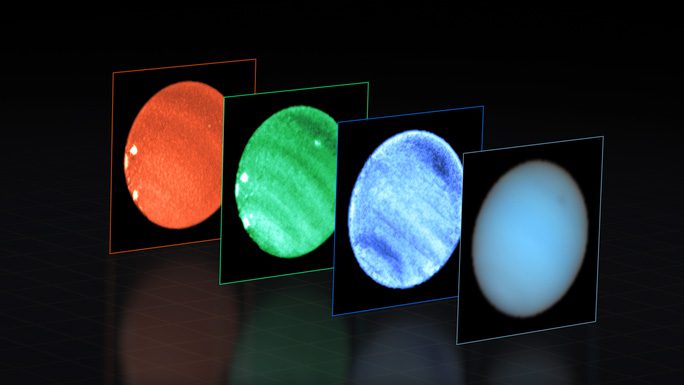A large dark region is growing and perplexing scientists on a planet within our Solar System, accompanied by a similarly mysterious bright spot nearby.
According to Space, this “phantom” is the development of a dark spot first observed by NASA’s Voyager 2 spacecraft as it flew past Neptune in 1989.
For the past 30 years, these giant dark and bright spots on the planet have continued to expand, leaving scientists “lost.”

Neptune’s atmosphere revealed by MUSE, disclosing many unusual details – (Photo: ESO).
Using the MUSE spectrograph from the Very Large Telescope (VLT) at the European Southern Observatory (ESO) in Chile, Professor Patrick Irwin from the University of Oxford and his team focused on one of the mysterious dark spots in the northern hemisphere of the planet.
This new observation contradicts previous hypotheses that these dark spots were caused by the appearance of clouds on the surface of the icy giant; it also dispels an older speculation that they resemble the Great Red Spot of Jupiter, a massive storm characterized by a large red mark.
The current dark spots have diameters of about 10,000 to 15,000 km, according to a presentation in the journal Science. Some previously unseen dark spots have also emerged.
Using MUSE to measure reflected light and analyze the color components, scientists found that these spots are actually not created by clouds.
Instead, they appear to be caused by particles in this atmospheric layer that are darker, disrupting other wavelengths of light and thus creating the dark spots.
The bright spot observed at the same level in the atmosphere of the area with the dark spot did not appear in observations from weeks prior, indicating that it is something newly formed.
Thus, fundamentally, the answer remains elusive. However, scientists hope to explore the composition of the atmosphere—where there may be darker particles—to find clues.
Another hypothesis suggests that a localized warming phenomenon on Neptune is occurring, transforming hydrogen sulfide ice from solid to gas, releasing fog-like clouds. However, of course, there is still no evidence to confirm this.
Scientists hope to shift their focus to observing the planet that is very close—compared to over 5,000 other known exoplanets outside our Solar System—yet still shrouded in mystery.


















































